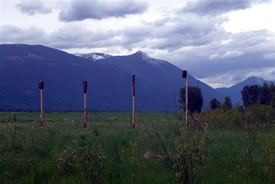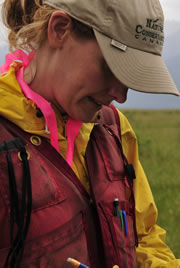Have you heard the one about the fun guys (fungi)? For Canada's bats and frogs, they're no April Fool's joke

The newly erected bat houses (Photo by Cori Lausen)
The Frog Bear Conservation Corridor in British Columbia’s Creston Valley has received a lot of attention for its promise of protecting migratory habitat for creatures large and small. Grizzly bear and elk share these lands with migratory birds, bats, amphibians and more. As someone intimately involved in the conservation of these lands, I too am excited by the hope and possibility that comes from securing key habitat for at-risk species.
But sometimes simply securing the land is not enough.
Right now a pair of fungal diseases that are affecting two of the prime species found on the Frog Bear Conservation Corridor: bats and frogs.
According to the Organization for Bat Conservation, white-nose syndrome has killed more than 5.7 million bats in eastern North America, and the disease is steadily advancing westward. Named for the white fungus that appears on the muzzle and other parts of hibernating bats, the syndrome generally kills 90 percent of the bats roosting in caves that are infected with white-nose.
The fungus is easily spread from roosting cave to roosting cave. One strategy to fight this syndrome, which has no known cure, is to enhance reproductive success through roost enhancement. Bats that survive white-nose can reproduce and hopefully enhance a population’s resistance to this ravaging disease.
According to Cori Lausen, a bat researcher with Wildlife Conservation Society Canada, it is essential that we identify roosting habitat prior to the disease arriving in western Canada. Her research has shown that bats may have higher reproductive success in human-made structures.
Last summer, in collaboration with the Kootenay Community Bat Project, we installed three different types of bat houses on the Nature Conservancy of Canada's (NCC's) Frog Bear lands in order to monitor the ones that work best. This will, we hope, help enhance roosting success for the bats that use these lands as habitat and a migratory corridor. Already the bat houses show signs of being used.
Another imminent threat to the wildlife of the Frog Bear Conservation Corridor is the chytrid fungus. Chytridiomycosis, caused by the chytrid fungus Batrachochytrium dendrobatidis, has been linked to northern leopard frog declines across North America as well as declines in approximately 6,000 of the world's amphibian species. Symptoms of the disease include skin peeling or sloughing, lethargy and behavioural changes. Fortunately, the single remaining population of frogs in the Creston Valley appears to be somewhat resistant to the disease and is holding steady in numbers.
NCC has joined forces with the Northern Leopard Frog Recovery Team to identify potential frog population enhancement measures in the Frog Bear area, including wetland restoration, educational signage and land use management. Preliminary experiments in creating more open water habitat in the wetlands in the Frog Bear area show promising signs of attracting the frogs to expand their range.
The threat posed by these two fungi highlights the fact that securement alone is not enough. We are hopeful that a combination of habitat securement and innovative stewardship can slow the march of white nose into western Canada or prevent further declines due to chytrid.


